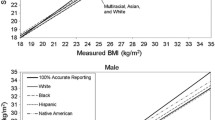Abstract
Objective The purpose of this study was to assess the accuracy of BMI categories based on self-reported height and weight in adult women. Methods BMI categories from self-reported responses were compared to categories measured during physical examination from women, age 18 or older, who participated in the National Health and Examination Survey, 1999–2004. We first examined strength of agreement using Cohen’s kappa, which, unlike sensitivity and specificity, allows for the comparison of polychotomous measures beyond chance agreement. Kappa regression identifies potential threats to accuracy. Likelihood of bias, as measured by under-reporting, was examined using logistic regression. Results Cohen’s kappa estimates were 0.443 for pregnant women (N = 724) and 0.705 for non-pregnant women (N = 5,910). Kappa varied by age and race, but was largely unrelated to socioeconomic status, health and health behaviors. Women who visited a physician in the last year or been diagnosed with osteoporosis were more accurate, while women most likely to under-report were older, white, non-Hispanic, and college-educated. Conclusions Our results suggest substantial agreement between self-reported and measured categories, except for women who are pregnant, above the age of 75 or without physician visits. Under-reporting may be more prevalent in well-educated, white populations than minority populations.
Similar content being viewed by others
References
DHHS-CDC. (2006). State-specific prevalence of obesity among adults—Unites States, 2005. Morbidity and Mortality Weekly Report, pp. 985–1012.
Kuczmarski, M. F., Kuczmarski, R. J., & Najjar, M. (2001). Effects of age on validity of self-reported height, weight, and body mass index: Findings from the Third National Health and Nutrition Examination Survey, 1988–1994. Journal of the American Dietetic Association, 101, 28–34. doi:10.1016/S0002-8223(01)00008-6.
Must, A., Spandano, J., Coakley, E., Field, A., Colditz, G., & Dietz, W. (1999). The disease burden associated with overweight and obesity. Journal of the American Dietetic Association, 282, 1523–1529.
Nieto-Garcia, F. J., Bush, T. L., & Keyl, P. M. (1990). Body mass definitions of obesity: Sensitivity and specificity using self-reported weight and height. Epidemiology (Cambridge, Mass), 1, 146–152. doi:10.1097/00001648-199003000-00011.
Schmidt, M. I., Duncan, B. B., Tavares, M., Polanczyk, C. A., Pellanda, L., & Zimmer, P. M. (1993). Validity of self-reported weight—a study of urban Brazilian adults. Revista de Saude Publica, 27, 271–276. doi:10.1590/S0034-89101993000400007.
Bostrom, G., & Diderichsen, F. (1997). Socioeconomic differentials in misclassification of height, weight and body mass index based on questionnaire data. International Journal of Epidemiology, 26, 860–866. doi:10.1093/ije/26.4.860.
Brunner Huber, L. R. (2007). Validity of self-reported height and weight in women of reproductive age. Maternal and Child Health Journal, 11, 137–144. doi:10.1007/s10995-006-0157-0.
Spencer, E. A., Appleby, P. N., Davey, G. K., & Key, T. J. (2002). Validity of self-reported height and weight in 4808 EPIC-Oxford participants. Public Health Nutrition, 5, 561–565. doi:10.1079/PHN2001322.
Nyholm, M., Gullberg, B., Merlo, J., Lundqvist-Persson, C., Rastam, L., & Lindblad, U. (2007). The validity of obesity based on self-reported weight and height: Implications for population studies. Obesity (Silver Spring, Md.), 15, 197–208.
Centers for Disease Control and Prevention NCfHSN. (1999–2004). National Health and Nutrition Examination Survey Data. Hyattsville, MD: US DHHS, Centers of Disease Control and Prevention.
McDowell, M. A., Hughes, J. P., & Borrud, L. G. (2006). Health characteristics of U.S. adults by body mass index category: Results from NHANES 1999–2002. Public Health Report, 121, 67–73.
Landis, J. R., & Koch, G. G. (1977). The measurement of observer agreement for categorical data. Biometrics, 33, 159–174.
Lipsitz, A. R., Williamson, J., Klar, N., et al. (2001). A simple method for estimating a regression model for κ between a pair of raters. Journal of Royal Statistical Society Series A, 64(3), 449–465. doi:10.1111/1467-985X.00213.
Shoukri, M. M., & Mian, I. U. (1996). Maximum likelihood estimation of the kappa coefficient from bivariate logistic regression. Statistics in Medicine, 15, 1409–1419. doi:10.1002/(SICI)1097-0258(19960715)15:13≤1409::AID-SIM269≥3.0.CO;2-N.
Efron, B.T. & Tibshirani, R. J. (1993). An introduction to the bootstrap (Monographs on statistics and applied probability) (1st ed.). Chapman & Hall/CRC.
Niedhammer, I., Bugel, I., Bonenfant, S., Goldberg, M., & Leclerc, A. (2000). Validity of self-reported weight and height in the French GAZEL cohort. International Journal of Obesity and Related Metabolic Disorders, 24, 1111–1118. doi:10.1038/sj.ijo.0801375.
Bolton-Smith, C., Woodward, M., Tunstall-Pedoe, H., & Morrison, C. (2000). Accuracy of the estimated prevalence of obesity from self reported height and weight in an adult Scottish population. Journal of Epidemiology and Community Health, 54, 143–148. doi:10.1136/jech.54.2.143.
Madrigal, H., Sanchez-Villegas, A., Martinez-Gonzalez, M. A., et al. (2000). Underestimation of body mass index through perceived body image as compared to self-reported body mass index in the European Union. Public Health, 114, 468–473. doi:10.1016/S0033-3506(00)00390-5.
Wada, K., Tamakoshi, K., Tsunekawa, T., et al. (2005). Validity of self-reported height and weight in a Japanese workplace population. International Journal of Obesity, 29, 1093–1099. doi:10.1038/sj.ijo.0803012.
Acknowledgements
The authors thank the staff members, Mary Palmer, Kelly Muenzenberger, Angeline Vanto, and Kevin Benish, for their support of this project.
Author information
Authors and Affiliations
Corresponding author
Rights and permissions
About this article
Cite this article
Craig, B.M., Adams, A.K. Accuracy of Body Mass Index Categories Based on Self-Reported Height and Weight Among Women in the United States. Matern Child Health J 13, 489–496 (2009). https://doi.org/10.1007/s10995-008-0384-7
Received:
Accepted:
Published:
Issue Date:
DOI: https://doi.org/10.1007/s10995-008-0384-7




